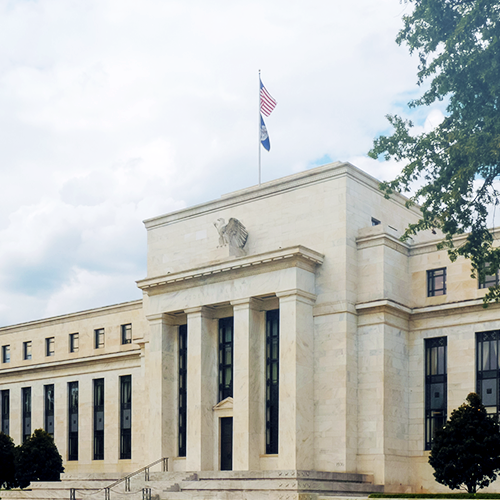
October 2024
Market Views of the Election
Plus: Opportunities in fixed income, Fed moves, and developments in the economy.
Download PDFWe recently sat down with Dominic Nolan, CEO of Aristotle Pacific Capital, to get his insights into the upcoming U.S. presidential election and its impact on the markets, opportunities in fixed income, developments in the economy, and the Fed’s next moves. We finished up with a wild-card round of questions and personal reflection.
Market Performance: Total Return

Equities and bonds ended another month in the green in September. What happened?
I think three things have been driving the performance. First, the Federal Reserve cut interest rates more than many expected. Second, the economy continues to show itself as resilient. We’ve recently used the phrase, “Growing, but slowing,” but I’d say the economy right now is “Growing and holding.” And three, inflation is settling down. I think of all this has driven positive returns. The Russell 1000 Growth Index, led by the Magnificent 7, continues to outperform, returning over 24.5% year-to-date, though Alphabet and Apple had negative returns in September. And we have seen a rebound in Russell 2000 Value Index, which was up over 10% for the quarter and 9% year-to-date.
Magnificent 7

What about on the fixed-income side?
With the Fed finally cutting interest rates more than expected, the Bloomberg US Aggregate Bond Index was up 1.3% for the month, over 5% for the quarter and 4.5% year-to-date. I think we’re very much in a coupon/coupon-plus environment with returns in the 4.5% to 8% range, depending on the asset class. It’s been a strong first nine months of 2024.
10-Year Treasury Yields Remain Range Bound

How are U.S. Treasuries trading?
In May, the 10-year Treasury was sitting at 4.5%, which seems very distant from today. What I found interesting is on Sept. 18, the day the Fed made its first rate cut, the 10-Treasury was yielding about 3.7%, and it’s actually higher today. So, you had the Fed cutting short-term rates by 50 basis points, yet the 10-year Treasury is now higher than when the Fed cut. The market—particularly the long end of the Treasury yield curve—is a discounting mechanism. Going forward, as it relates to investors, do an extra 25 basis points matter? The Fed’s signaling has been important, and now the central bank is signaling it’s willing to be dovish. I think for investors, that was a pleasant surprise, and it’ll take pressure off this tight monetary policy we’ve seen over the past couple years.
Economic Dashboard: GDP, Inflation, Jobs, and Consumer Spending

What's the current data telling us about the economy?
The Atlanta GDPNow is forecasting Q3 GDP to be 2.5%, which I believe to be healthy—not too hot, not too cold. Year-over-year Inflation has dropped 2.5%. On the jobs front, August saw a rebound in non-farm payrolls, but it’s still slower than a year ago. The economy is less hot today, but I think it is in a decent place. Plus, volatility has dissipated. Keep in mind consumer confidence in general is lower than a year ago. But so is inflation. Overall, I think the economy is in a nice place. The key is how long this can last without it becoming too hot or too cold.
Fed Futures: Accelerating Timing of Rate Cuts (Cuts Expected into July 2025)

The Fed cut interest rates by 50 basis points in September. What do you see ahead?
Since the Fed’s cut in September, expectations for further cuts have increased. Fed futures have the fed funds rate 75 basis points lower by the end of the year and a total of 100 basis points lower by the end of January. That covers three FOMC meetings, which means in one of those meetings, the market is expecting a 50-basis-point cut. I think the market’s getting a little ahead of itself. That said, expectations are for consistent rate cutting through July of next year.
End of the Inversion?

How does this all play out for bond investors?
For some time now, the question has been: Will we go into a recession? I think if the 2-10 Treasury yield curve remained inverted and the 10-year dropped substantially. That’s forecasting a much slower economy. But if the curve is flat to normal, that would indicate to me a soft landing for the economy. Currently the 2-10 curve is flat to normal, which signals a soft landing.
The part to me that’s a bit off are the expectations of fed cuts. I think the market has gotten too aggressive on the predicted number and size of the cuts. We’ll see who’s right—the long bond investors, the equity investors, or the Fed watchers. I would trust the long bond investors and equity investors over the Fed watchers given what we’ve seen over the past few years.
The KEYstone State

Let's turn to our special topic: "Market Views of the Election." By nearly all accounts, the presidential election right now is extremely close.
As it relates to the popular vote, both parties expect that Vice President Harris will receive this. However, that is not how POTUS is decided. If we break down the betting markets, in particular, the odds of each state going blue or red via Polymarket—a large prediction market—the race is extremely tight. Keep in mind, the candidate will need 270 electoral votes to win. So, if we were to consider the candidate who has a probability of more than 70% to win a state, the tally would be 226 electoral votes for Harris and 219 for former President Trump. Currently, Michigan and Wisconsin are leaning Harris, which takes her total to 251. Conversely, Arizona, Georgia, and North Carolina are leaning Trump, which would take his total to 262. This leaves Nevada and Pennsylvania. Nevada with six electoral votes doesn’t clinch for either candidate, which means the 19 votes from Pennsylvania is the key to victory. In my opinion, the election goes the way of Pennsylvania. We will see.
Market Performance: Democratic vs. Republican Administrations

Has historically the economy performed better under Democratic or Republican administrations?
Whether Kamala Harris or Donald Trump are elected president, let’s assume Congress is split. Current expectations have the GOP controlling the Senate and Democrats controlling the House. In a divided Congress scenario, since 1933, the S&P 500 Index performance has been nearly identical: 13.6% for Democratic presidents and 13.7% for Republican presidents. So, for nearly a century, when Congress was split, asset prices weren’t affected dramatically no matter which party was in the White House.
As for GDP growth, the needle has barely budged under Republican and Democratic presidents in the 21st Century. The strongest GDP numbers were under George W. Bush (2.40%), but the lowest GDP growth was only 20 basis points lower under Joe Biden. What all this it tells me is the economy and capital markets have shown they adjust to policy.
What wild cards might affect the presidential election and upset markets?
A wild card that could help Democrats is the battle over reproductive rights. On the other side, I feel if the Middle East conflict escalates, that could shift some momentum to the Republicans, who some may see as having more experience with foreign policy.
Fixed-Income Yields and Year-to-Date Returns

Let's pivot to bonds. Where do you see opportunities in fixed income today?
So far this year, bonds are returning coupon/coupon plus. I continue to be constructive on investment-grade corporate bonds. Thinking about interest-rate sensitivity, I feel duration is at the higher end of things. Even though rates for the U.S. Treasury 10-year note are hovering around 3.75%, you’re still clipping close to 5% on investment-grade corporates. Meanwhile, bank loans continue at about a
2%-a-quarter clip and are on pace for 8% to 9% for the year. The forward curve yields are still in the 8% range.
Let's go to the random round. I'll give you a word or phrase, and you give me your thoughts. Let's start with Intel.
To me, Intel has been surpassed by competitors in recent years. Nvidia is just eating their lunch, and it’s staggering. Intel feels like a dinosaur.
23andMe.
The entire Board of Directors recently resigned because 23andMe’s founder, Anne Wojcicki, wanted to take the company private. I can see both sides of the conflict, but she owns 49% of the business, so she can pretty much do what she wants.
Boeing strike.
The ask from labor is a 40% pay raise over four years and restoration of a defined-benefit pension, which was taken away a decade ago. Management is offering a 30% increase in wages over four years.
The consistent theme with labor is if there’s weakness in your counterparty, you strike. And that’s what’s happened. They see weakness in Boeing. At the same time, there needs to be caution about a negative feedback loop: When the cost of labor increases, capital and reinvestment decreases, thus the product can get worse. In the end, it’s about labor taking advantage of a weak counterparty. Capital Market investors do this on a regular basis, so labor doing this should not be viewed as malicious.
Mortgage refinancing.
Good for borrowers.
Antitrust cases against Visa and Google.
The Google one is very interesting. It may be a seminal moment in tech. We’re in an era of large companies getting bigger, dominating, and exerting their force.
If you were to ask me, “Is Google a monopoly in search?” I’d say, “Yes.” If you ask, “Is Visa a monopoly in transactions?” I’d again reply, “Yes.”
Winners of falling interest rates.
Mortgage companies for sure. And anyone with leverage, which is almost everyone.
Let’s close with a personal reflection.
I have a close friend whose company decided to give a special bonus to everyone—despite the business having a difficult year. They just wanted to acknowledge everyone’s hard work. After receiving the bonus, my friend actually called the CEO and thanked him. It turns out he was the only person in the company to do that.
This got me thinking about the power of gratitude, especially the power of a thoughtful—not casual—thank you. Keep in mind the absence of a thank you is also powerful. “Thank yous” are free. So, from my perspective, if you have the opportunity for a heartfelt thank you, take it. It’ll mean a lot more than you think.
Definitions
The 2-year Treasury yield is the interest rate the U.S. government pays to borrow money for two years.
The 10-year Treasury yield is the interest rate the U.S. government pays to borrow money for a decade.
Bank loans (or floating-rate loans) are financial instruments that pay a variable or floating interest rate. A floating rate fund invests in bonds and debt instruments whose interest payments fluctuate with an underlying interest rate level.
Basis points, otherwise known as bps or bips, are a unit of measure used in finance to describe the percentage change in the value or rate of a financial instrument. One basis point is equivalent to 0.01% (1/100th of a percent) or 0.0001 in decimal form.
The Bloomberg US Aggregate Bond Index (Agg) is composed of investment-grade U.S. government bonds, invest-ment-grade corporate bonds, mortgage pass-through securities, and asset-backed securities, and is commonly used to track the performance of U.S. investment-grade bonds.
The Bloomberg US Credit Index measures the investment grade, US dollar-denominated, fixed-rate, taxable corporate and government-related bond markets.
The Consumer Price Index (CPI) is a measure that examines the weighted average of prices of a basket of consumer goods and services such as transportation, food, and medical care. It is calculated by taking price changes for each item in the predetermined basket of goods and averaging them. Changes in the CPI are used to assess price changes associated with the cost of living.
A coupon or coupon payment is the annual interest rate paid on a bond, expressed as a percentage of the face value and paid from issue date until maturity.
The effective yield is the return on a bond that has its interest payments (or coupons) reinvested at the same rate by the bondholder.
Fed funds futures are a tool used by traders and institutions to hedge or bet on changes in the federal funds rate, which is key to U.S. monetary policy.
The federal funds rate is the target interest rate set by the Fed at which commercial banks borrow and lend their extra reserves to one another overnight.
The Federal Open Market Committee (FOMC) is the branch of the Federal Reserve System that determines the direction of monetary policy.
Gross Domestic Product (GDP) is the total monetary or market value of all the finished goods and services produced within a country's borders in a specific time period. The nominal GDP growth rate compares the year-over-year (or quarterly) change in a country’s economic output to measure how fast an economy is growing. Real GDP is GDP adjusted for inflation.
GDPNow is a forecasting model that provides a "nowcast" of GDP growth.
High-yield bonds are debt securities, also known as junk bonds, that are issued by corporations.
An inverted yield curve occurs when the yield on 2-year Treasuries is higher than the yield on 10-year notes.
Investment grade refers to the quality of a company's credit. To be considered an investment grade issue, the company must be rated at 'BBB' or higher by Standard and Poor's or Moody's.
Leverage refers to using debt (borrowed funds) to amplify returns from an investment or project.
The Russell 1000 Growth Index measures the performance of the large-cap growth segment of the U.S. equity universe. It includes those Russell 1000 companies with higher price-to-value ratios and higher forecasted growth values.
The Russell 2000 Value Index measures the performance of the large-cap value segment of the U.S. equity universe. It includes those Russell1000 companies with lower price-to-book ratios and lower expected growth values.
The S&P 500 Index is a stock market index tracking the performance of 500 large companies listed on stock exchanges in the United States.
The S&P 500 Equal Weight Index is the equal-weight version of the widely used S&P 500 Index, which is a stock market index tracking the performance of 500 large companies listed on stock exchanges in the United States.
Spread is the measurement of the spread of a fixed-income security rate and the risk-free rate of return, represented by treasury bonds. Spread income refers to the additional income from this difference.
Volatility is a statistical measure of the dispersion of returns for a given security or market index. In most cases, the higher the volatility, the riskier the security.
Yield is the income returned on an investment, such as the interest received from holding a security.
A yield curve plots the interest rates of bonds that have equal credit quality but different maturity dates.
Yield-to-worst is the lowest potential yield that can be received on a bond without the issuer defaulting.
Any performance data quoted represent past performance, which does not guarantee future results. Index performance is not indicative of any fund’s performance. Indexes are unmanaged and it is not possible to invest directly in an index. For current standardized performance of the funds, please visit www.AristotleFunds.com.
The views expressed are as of the publication date and are presented for informational purposes only. These views should not be considered as investment advice, an endorsement of any security, mutual fund, sector or index, or to predict performance of any investment or market. Any forward-looking statements are not guaranteed. All material is compiled from sources believed to be reliable, but accuracy cannot be guaranteed. The opinions expressed herein are subject to change without notice as market and other conditions warrant.
Investors should consider a fund’s investment goal, risk, charges and expenses carefully before investing. The prospectus contains this and other information about the fund and can be obtained at www.AristotleFunds.com. It should be read carefully before investing.
Investing involves risk. Principal loss is possible.
A full list of holdings can be found at www.aristotlefunds.com and are subject to risk and to change at anytime. Any discussion of individual companies is not intended as a recommendation to buy, hold or sell securities issued by those companies.
Aristotle Funds and Foreside Financial Services, LLC are not affiliated with Pacific Life Fund Advisors LLC.
Foreside Financial Services, LLC, distributor.



